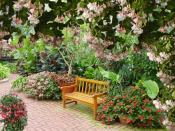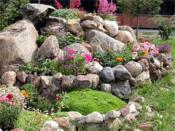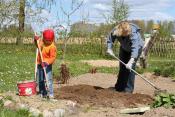Search
Login
The border is garden, materials for a border, installation of borders, how to do it right
A beautiful curb will help to give a finished look to a garden path, sidewalk, flowerbed - one of the elements that is present in the design of the local area or the creation of a landscape garden. Installation of borders - work that can be successfully performed even by those owners of country estates who do not have the skills to do construction work with their own hands - it will be enough to think about what material to make borders and do the work in accordance with the recommendations of specialists.
Content:
- Types of borders videovideo
- Road curbs, materials for their manufacture, quality requirements
- Garden borders and their purpose
- How to install concrete pavement curbs
Types of borders

Borders can serve to design different elements of the garden landscape, depending on how and where they are used, they can be road or pavement, as well as be elements of garden decor.
Materials for the manufacture can also be very diverse:
- granite and sandstone,
- brick or concrete
- wood and shell rock,
- metal and artificial materials such as plastic,
- various tools at hand
- living thickets of small plants.
The use of some of them is limited by the impracticality of materials, for example, irregularities on sandstone fragments allow grass and weeds to germinate, which makes it difficult to care for such fences. When choosing a border for garden paths, it is better to give preference to materials with strict, geometrically correct outlines, which can be laid in one dense line.
Road curbs, materials for their manufacture, quality requirements
In terms of functionality, curbs are also different: they can serve as fences, in particular to separate the carriageway from the sidewalk. They are made from durable, wear-resistant materials such as concrete or natural stones.

Granite curb, for example, is different:
- long period of operation,
- strength
- ability to withstand strong shocks and large physical loads, give greater reliability to the roadway,
- aesthetic appearance and attractiveness.
Granite curbs have the correct geometric shape and a flat surface, they are also called side stones. Road curbs are installed during the construction of the roadway, but sometimes their installation is performed as a separate section of the work. Most often, concrete cast stone, with a metal reinforced frame, is used as road bordering.
Garden borders and their purpose

Very different requirements are imposed on garden borders - they may not be very durable, but they must have an attractive, decorative, original look.
The main tasks:
- creating a barrier to the spread of plants,
- prevention of paving of paved paths,
- protection against the germination of grass located on the sides of the path,
- extending the life of garden paths,
- creating obstacles to the flow of washed-out soil during irrigation or natural precipitation.
The sizes and configuration, the color of garden fences can be the most diverse.
plastic pavement border

The cost of such a border is low, is the simplest of the fences, which, however, can provide a sufficient degree of protection for the track. You can use a plastic border in any landscape design - its appearance is very simple and does not attract too much attention.
Useful points in using a plastic border will be:
- durability and the possibility of long-term operation,
- convenience and ease of installation and dismantling,
- ability to withstand the effects of chemically active substances.
A plastic border can be used to frame paths in a sinuous shape, children's sandboxes and multi-tiered flower beds; its installation does not require special preparation, i.e. drainage facilities or trenching. The original design of the product provides for mounting fragments of the curb with the help of special pins sold in the kit.

Plastic borders come on sale in block or roll form, this greatly simplifies the process of their transportation. The most common plastic borders of the following models:
- Country - thickened from one edge, resistant to fading and difficult climatic conditions. Available in several colors: green, black, terracotta.
- Labyrinth - made of light plastic, resistant to the effects of the sun and frost, in appearance its blocks resemble a natural stone.
- The old stone is a typesetter that allows you to collect imitation of different types of masonry.
- Garden constructor - multi-colored decorative fragments of which are ideally suited for fencing lawns, flower beds and paths, they allow emphasizing their most diverse outlines.
- Garden board - produced in the form of a tape of various bright colors, designed to limit sandboxes, flower beds, beds, its texture can be wavy, corrugated, flat. The plastic sidewalk does not need special care.
metal border
Like a plastic counterpart, it performs protective functions, but does not make the track more attractive.

The shape of the metal border is a tape made of steel, aluminum or copper, for its installation it will be necessary to dig into the ground by about 10 cm, so that 1.5 - 2 cm of the border are visible above the surface. Such borders perform well the functions assigned to them, but they do not differ in a particularly attractive appearance.
advantages of wood borders
This version of the garden path fence allows you to show your creativity and suggests the possibility of creating a creative option. As the material for the border, wood can be used in the most diverse form, it can be:
- pegs, saw cuts,
- bars along the tracks,
- shingle,
- boards.

To diversify the landscape design, the processing of wood fragments will help - they can be painted, fired, carved. In addition to the wooden border, you can also place wooden garden figures made in a similar style on a flowerbed or lawn, a well, a gazebo, a windmill. A wooden border of the desired size and shape can be purchased in stores, and at a very low cost.

Among the shortcomings of the wooden frame, a relatively short service life can be noted, even if all the processing technologies of the material and its installation are observed, it will last no more than ten years.
Installation of a wooden fence will require the implementation of preparatory work:
- wood treatment with antiseptics
- removing the topsoil,
- drainage facilities,
- waterproofing works.
curbs for brick walkways

Immediately, we note that they can be considered traditional, which are popular. The dimensions of the brick are quite large, the framing of bricks will allow you to make a noticeable change in the design of the garden, emphasize the shape of the path, give them expressiveness and an elegant look. Facing bricks should be used facing:
- they look more attractive
- they are characterized by higher strength, resistance to water and low temperatures.
Brick is laid, usually at an angle, while digging it into the ground.

But if you wish, you can build a track from vertically or horizontally placed products. Brick is framed not only by garden paths, but also flower beds, borders of artificial reservoirs.
paving curbs made of natural stone

The material for creating such a border has considerable cost, but the money spent will more than pay off in the result: a natural stone fence will become a real decoration of the landscape of a suburban area. For work, you can take:
- gravel or pebbles beautiful in color and shape,
- granite or marble fragments,
- sandstone, shell rock, limestone.
Such fences are perfectly combined with paths lined with paving stones, natural or artificial stone, paving slabs. Installation of a stone curb will be required in all seriousness, i.e. digging a shallow pit, arranging drainage, tamping. In addition, a double layer of agrofibre should be placed in the trench - this will prevent the possibility of weed growth.

When choosing stone fragments, you need to track the similarity of the size of the stone and check the possibility of its tight installation. If gaps will form between the stones, then they will need to be filled with material with a smaller fraction.
how to create green borders with your own hands

A green border is a strip of plants planted in a dense array along the paths. Creating such a wonderful fence will not require large funds, but the creator will need the ability to select the suitable plants, you will also need to have patience - the results of the work can not be seen right away - the plants must take root and acquire the appropriate shapes and dimensions. Mandatory will be the systematic care of living plantings:
- watering,
- fertilizer application
- pruning.
The results of such painstaking work very naturally fit into the design of any garden, emphasize its romantic atmosphere. Experts recommend choosing for planting low plants with a luxurious crown, adapted for life in certain climatic conditions, with minimal care requirements, distinguished by a decorative look.

Recommended dimensions of a live border:
- height about 30 cm
- width 25-30 cm.
If preference is given to larger plants, then instead of a curb, a hedge will be obtained, its height can reach up to 2.5 m.
Most often, borders are created from boxwood or cotoneaster horizontal. Green borders will worthily decorate paths from any material.
How to install concrete pavement curbs
Quite often on the suburban area you can find sidewalk concrete curbs. Since they are a drip structure, the technology of their installation should be considered in more detail.

First of all, you need to make markings on the ground: determine the place, drive in the pegs and pull the cord along the marked lines. Dig along them a trench about 20 cm deep - for a sidewalk curb or 30 - for a road. The soil in the trench must be carefully tamped, then fill up the bottom with gravel and ram again. Crushed stone is covered with a layer of sand, filled up with water for compaction and again rammed.
To make the installed curb look beautiful, you will need to repulse the line indicating the height. Installation work should be carried out accurately, keeping track of the correct installation horizontally and vertically.
Directly installation work begins with the preparation of concrete mortar of the following composition:
- sand - 2.5 parts,
- cement - 1 part,
- fine crushed stone - 2 parts,
- water - 2 parts.
The solution is poured onto previously compacted sand and leveled. Then you can proceed with the installation of the curbstone. To work more conveniently, you can use a rubber hammer, it will be required to adjust the height of the border and the depth of immersion in concrete.
To fix fragments of the curb, a cement mortar should be applied at the junction. Having checked once again the correct installation of the fragments, it is possible to fill the concrete voids in the trench with the remains of concrete.
To close the joints between individual fragments, you can fill the cracks with a mixture of sand and cement, pour water, wait until the mixture has completely hardened.

Laying the road curb is carried out according to the same principles.





